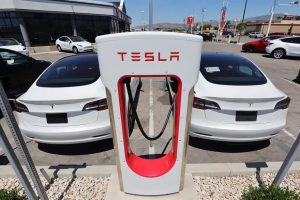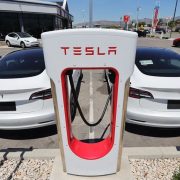Ready to try an electric car? Good luck finding one in Utah
By

Now that you’re flush with cash from pandemic-induced savings and a series of federal stimulus checks, it may feel like the perfect time to buy your first electric vehicle.
But if you’re a Utah resident, you might want to keep that extra-long extension cord bundled up for the time being.
A global shortage in the high-tech semiconductor chips that have become the lynchpins of modern automotive manufacturing was first noticed last fall, and the fallout has been impacting the global car market ever since. The problem rose to become a major issue for automakers, with some manufacturers significantly slashing production of some of the world’s most popular models and, in some cases, holding off on releasing new, all-electric vehicles.
The result has been far fewer vehicles available for purchase as the waning pandemic has lit the flame on pent-up consumer demand for a new ride. Given the robust customer interest, dealers likely could sell many more cars and trucks — if they were available.
Why is automotive supply low?
While restrictions wrought by the COVID-19 pandemic laid waste to large swaths of the retail sector, car sales actually fared very well and, in Utah, were up significantly even in the early months of the health crisis. Now, however, the supply side of the equation is wreaking its own kind of havoc.
“The car industry is doing OK, and we will hopefully come out of COVID OK,” Craig Bickmore, executive director of the New Car Dealers of Utah association, told the Deseret News last month. “The dealers have done OK and we’re grateful. But what’s happening now is inventories are tight for reasons that have been in the news a lot — inventory is tight and will probably get a little tighter as manufacturers work through those issues with supply chains.”
And nowhere is this economic dilemma more evident than in an unprecedented confluence of record-high interest in electric vehicles and a meager, if not nonexistent, number of the battery-powered buggies available on dealership lots not just in Utah but across the country.
Even large Salt Lake dealerships have only a few, if any, all-electrics available for purchase and the world’s biggest electric vehicle maker, Tesla, is citing a wait of up to three months for their “entry level” Model 3, which starts at just under $40,000.
:no_upscale()/cdn.vox-cdn.com/uploads/chorus_asset/file/22638226/merlin_2873145.jpg)
Glen Schmidt, who chairs the department of operations and information systems at the University of Utah’s David Eccles School of Business, said electric vehicle manufacturers were preparing for a big market jump a couple of years ago that never really came to fruition. But now that surge appears to be in full effect.
“There’s something called the S-curve in product innovation,” Schmidt said. “You hit an inflection point where all of a sudden things take off. Things like battery production were ramping up a few years ago when automakers thought demand was going to take off, but it didn’t happen.
“Now, it seems that we’re finally there.”
And new data from Cox Automotive’s report on U.S. auto sales for the first quarter of 2021 supports the contention that interest in electric vehicles has been truly sparked.
U.S. sales of hybrid and electric vehicles were up 81% in the first quarter of 2021 over the same time period last year, and now account for 7.8% of all U.S. auto sales, up from 4.8% a year ago.
Cox reported that there are now more than 60 hybrid or plug-in hybrid vehicles available in the U.S. Tesla currently outpaces all competitors, and sold over 69,000 vehicles in the first three months of the year. The Tesla Model Y is top seller so far in 2021, with the Model 3 in second place and the Chevrolet Bolt rounding out the top three choices among U.S. buyers.
The battery problem
Beside the current supply line disruptions featuring very low inventories of microchips, Cox warned that ongoing high levels of demand for hybrid and electric vehicles may create pinch points in another critical area for these high-tech vehicles — batteries.
“Electrified vehicle growth in the U.S. and around the world is shining a spotlight on battery development and sourcing,” Cox Automotive executive analyst Michelle Krebs said in a statement. “As the industry builds more vehicles with battery packs, sourcing of these parts and lifetime management of the battery cells is a critical hurdle the industry must clear.”
What’s behind the sudden, if long-anticipated, uptick in consumer interest in electric cars?
Schmidt said it may simply be a function of a critical nexus that includes growing awareness among buyers, prices coming down and marquee brands driving up perceptions of cachet when it comes to electric vehicles.
“The cost of the technology is coming down, and people are more widely realizing that electric vehicles outperform cars and trucks with internal combustion engines,” Schmidt said. “And you really can’t talk about rising interest in electric vehicles without recognizing Tesla’s success in making the electric car a status symbol.
“What’s happening now is a culmination of all these things.”
Utah and zero-emission policies
Industry watchers note that domestic and international vehicle manufacturers have cause to push most of their inventory to states that have zero-emission policies in place and/or cash incentives for those looking to take the plunge into electrified driving. While federal zero-emission legislation has lagged, almost a dozen states have adopted 100% clean-emission targets as well as numerous U.S. municipal governments.
Utah lawmakers have yet to adopt a defined plan for getting the state to zero emissions, and axed a rebate program for electric vehicles a few years ago. In spite of that, the state is still seeing a significant growth arc when it comes to electric vehicle ownership.
According to Utah Tax Commission records, the state had only 1,646 electric vehicles registered just five years ago in 2016. Fast forward to 2021, and that number is nearing 11,000. Last year, Salt Lake City’s sustainability office, SLCgreen, reported the volume of electric vehicle charges taking place on its network of 36 public EV charging stations had almost quadrupled between 2017 and 2019.
And while there is a growing awareness of the full cost of getting to a zero-emission landscape, including the environmentally harsh processes of mineral extraction and how to manage batteries and their inherent toxins after they’ve outlived their usefulness, electric vehicle owners can expect to see their operating budgets shrink significantly.
This week, the U.S. Department of Energy is reporting the cost of a gallon of regular gasoline is $2.85 on average across the country while an eGallon (a unit devised to aid comparing the cost of recharging an EV to an internal combustion-powered vehicle) was at $1.16. And manufacturers claim the maintenance costs of electric vehicles also run significantly lower, thanks to fewer moving parts and simplified engines and braking systems.
An additional perk in Utah is that, for a $10 administration fee, you can cruise your electric vehicle down any state HOV lane even without the usual two person minimum or toll required for single occupancy drivers.
Utah Department of Transportation traveler information manager Lisa Miller said the state’s 6,650 limit on clean vehicle permits for using highway HOV lanes was maxed out a couple of years back, but since the program dropped hybrids off the eligibility list and now limits permits to all-electric vehicles, a lot of spots have opened up. As of last week, Miller said there were over 2,300 permits available to EV drivers.
Source:Is there a shortage of electric vehicles? Pandemic disrupts EV supply – Deseret News




